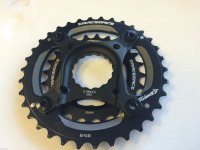What I need is a 48T freewheel between right side crank arm and the fixed sprocket that connects to a forward mid-drive that has a fixed sprocket. I need the crank to function normally 90% of the time with little to no drag, but have the ability to throttle a low cadence rpm mid-drive only when climbing hills.
A right side freewheel crank with LH threads and 3 prong grooves might work by screwing a LH thread flanged freewheel on first, then a 3 prong flange attached with a large locking nut/ring...
Cutting up a large flange rear freewheel hub and mounting it to the crank fixed sprocket on the right side "might" work, IF I can find a flat Race Face CINCH 28T sprocket that has its' inset lip towards the outer diameter. I think Wolf Tooth might make such a sprocket (?)...
The issues I keep running into are:
1) Left side freewheel crank with RH threads will work fine, BUT most frames (including mine) will not allow a 48T sprocket on the left side.
2) A right side freewheel crank with RH threads that accepts both sprockets on one freewheel like is commonly sold, requires a freewheel at the motor too, BUT no 11mm bore freewheels exist with less than 12T (if you can even find one) and the flip-flop adapters made start at 13T; I need to run a 9T.
3) The FS MTB bike application is a carbon frame and I don't want the weight or complexity of a jackshaft setup. All added weight will be DEAD WEIGHT 90% of the time. Trying to keep that less than or about 6lbs (or about the weight of 2 full water bottles).
4) The motor being used is a simple light weight 9.78:1 geared reduction MY1018 450W 24V brushed motor that needs to be further reduced to a managable cadence speed at the crank: thus the large 5.33:1 (48T/9T) of further reduction goal. The motor specifications state 440rpm at 24V, but I may run it at 36V, so that will increase the rpm's further.
Hopefully that gives you enough information to see what I'm trying to do, so my 230lb 57 year old body can stay in the game for those incredible downhill runs that keep me living extra large.

Of utmoost importance is that the MTB needs to pedal like there is no additional drag when not under power AND the weight has to be kept to an absolute minimum. Any and all ideas or suggestions are greatly appreciated.



